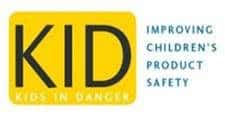Recalls Drop, But Little Progress Getting Them out of Consumer Hands

Recalls Drop, But Little Progress Getting Them out of Consumer Hands
Recalls Drop, but little progress in getting them out of consumer hands a new report shows.
(CHICAGO) March 10, 2015. The nonprofit Kids In Danger (KID) just released their 15th annual report on recalled children’s products. The first part of the report covers 2014 recalled children’s products. The number of recalls as well as the number of incidents, injuries, and deaths that happened before the recall all dropped from last year’s numbers. However, there were still several huge recalls this year; including two separate recalls of millions of dangerous strollers.
Because it isn’t enough to just issue a recall, the next part of the report took a look at how often companies use websites like Facebook and Twitter to warn consumers of the dangerous children’s products that might be in their homes. KID found that while three-fourths of all the companies that had a children’s product recall used Facebook and Twitter regularly, only one-fourth of these same companies used those platforms to reach their consumers with recall news.
We live in a world where only 4% of recalled products in consumer homes are reportedly disposed of or fixed. Perhaps if more companies used social media to warn consumers, then we could finally start getting dangerous children’s products out of our homes.
But things are getting better. Over the past decade, strong mandatory standards have been on the rise thanks in no small part to Danny’s Law. The rise in strong mandatory standards was linked to a fall in deaths. When a mandatory standard was made to remove drawstrings from kids’ clothing, there were no more strangulation deaths related to drawstrings. Sometimes a kid’s hoody with drawstrings would pop up on retailers’ shelves after the standard, but thanks to the standards these products were removed before they had the chance to kill. This held true for almost every type of hazard. Only choking deaths on small toy parts bucked the trend.
“Stronger standards, port surveillance and testing requirements have reduced recalls and improved safety,” Nancy Cowles, Executive Director of Kids In Danger summed up the report. “We need to keep strengthening that safety net and address the gap between recalling a product and getting it out of our homes.”
While KID and other like-minded organizations continue to push to protect children from dangerous products, you can do your part to protect your kids by checking out SaferProducts.gov for recall and injury information that might protect your family.
You can also sign up for safety updates at KidsInDanger.org. Accessing KID’s website on a mobile device allows consumers to search for recall information while shopping or considering a second-hand product. In addition, parents should report problems with a product both to the manufacturer and at SaferProducts.gov, and urge elected representatives to make strong standards and recall effectiveness a priority.
Although recalls drop; it is important to check prior recalls to make sure you do not have an item that has been on a recall list. Recall drops have been helped by making issues known, but getting the items out of the homes is what is also very important.
What's Your Reaction?
Newly middle-aged wife of 1, Mom of 3, Grandma of 2. A professional blogger who has lived in 3 places since losing her home to a house fire in October 2018 with her husband. Becky appreciates being self-employed which has allowed her to work from 'anywhere'. Life is better when you can laugh. As you can tell by her Facebook page where she keeps the humor memes going daily. Becky looks forward to the upcoming new year. It will be fun to see what 2020 holds.



